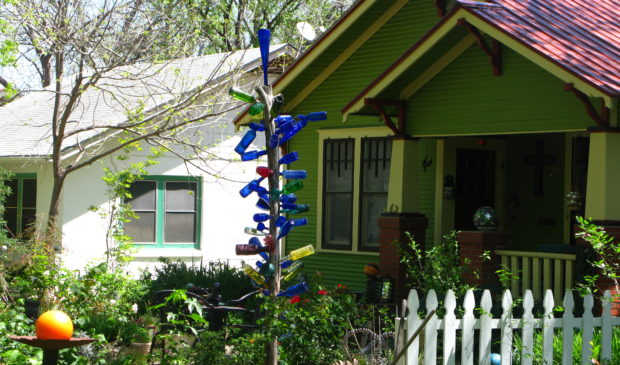Historic Landmark Commission expresses displeasure at preservation efforts in LDC draft
Thursday, November 21, 2019 by
Jessi Devenyns As Council’s first vote on the new Land Development Code draft inches ever closer, the Historic Landmark Commission publicly weighed in at its Nov. 18 meeting – and its reaction was not a positive one. Of particular concern was the “preservation incentive,” which received an icy blast of the commissioners’ ire.
The preservation incentive that is included in the new draft of the code outlines what changes may be made to a building that qualifies as historic. It includes measures regulating wall removal, foundation alteration and adding habitable space.
“The phrase ‘preservation incentive’ has been bandied about. The mayor has told countless neighborhoods that we have this preservation incentive. But when I read the code – and I did read the sections of the code that have to do with preservation incentive – you only have to preserve 50 percent of the studs,” said Commissioner Terri Myers. “My question is, what does it preserve?”
Other commissioners expressed concern about the language surrounding preservation, with many saying that the current language encourages tearing down homes rather than rehabilitation.
Brent Lloyd, from the city’s Development Services Department, said, “We agree that significant changes are required.” He offered no specifics on what the changes will entail.
Commissioners were not the only ones to express worry about the language outlining the draft code’s preservation incentive. Preservation Austin sent a formal comment to the commission to express its concerns. In the document, the nonprofit explained, “As currently written, the preservation incentive does little to discourage the demolition of existing buildings.”
In fact, Commissioner Witt Featherston said that as written, the preservation incentive only incentivizes more housing.
To encourage staff to rework the section of the code related to preservation, the commission voted unanimously to recommend that staff either include a significant increase in preservation activities or rename the provision, omitting the word “preservation.”
“Preservation incentives should incentivize preservation and not just remodeling,” said Commissioner Beth Valenzuela.
Another pressing question for the commissioners was whether the new zoning entitlements associated with transition zones would supersede the protections for historic structures. The two goals can often clash when economic incentives promote redeveloping with multiple smaller units. Historic neighborhoods cannot support the volume of housing allowed with increased density entitlement, pointed out Commissioner Kevin Koch.
Lloyd said when a property is subject to multiple regulations that appear in conflict, the more restrictive regulation applies. For homes in local historic districts, those protections will override the entitlements of transition zones. In the draft code, Lloyd indicated that there is a specific provision that outlines this hierarchy.
Commissioner Myers said it is imperative that the city persists in protecting historic zoning as it develops the transition zones. “People are saying (transition zones) only affects 2 percent of the city, but it affects 50 percent of the central city neighborhoods,” she said.
Lee Simmons from the city law department told commissioners that the areas of the new land development code that deal with preservation were intended to be a cleanup rather than a wholesale rewrite. He noted that the provisions related to historic home maintenance and demolition by neglect remain intact and that the window in which a structure becomes eligible for historic zoning is reduced from 50 to 45 years.
Still, commissioners and residents were not mollified. Several dozen people attended the commission meeting, and although the discussion item was not scheduled for public comment, the commission opened up the floor for citizens to speak.
Betsy Greenberg, who sits on the Ethics Review Commission, said that the draft code encourages demolition and replacement rather than preservation. “I expect the entire stock of older housing … to quickly disappear,” she said.
Former Planning Commissioner Karen McGraw noted, “I’ve been around long enough to know that if someone is entitled to 10 or 11 dwelling units, they’re going to get those.”
In the face of widespread concern, Lloyd reminded citizens and commissioners that often properties are not able to take advantage of their full zoning entitlements.
Still, commissioners remained worried. To enumerate their concerns more formally, the commission voted 6-1 to send a list of recommendations to Council. Myers voted against the motion, saying more time is needed to review the Land Development Code and its effects on historic properties. Commissioners Emily Hibbs, Kelly Little and Alex Papavasiliou were absent.
As for the language that is currently in the draft code, Commissioner Ben Heimsath said, “It’s more consistent with the standards of the building code … don’t call that preservation.”
Photo by Kari Sullivan made available through a Creative Commons license.
The Austin Monitor’s work is made possible by donations from the community. Though our reporting covers donors from time to time, we are careful to keep business and editorial efforts separate while maintaining transparency. A complete list of donors is available here, and our code of ethics is explained here.
You're a community leader
And we’re honored you look to us for serious, in-depth news. You know a strong community needs local and dedicated watchdog reporting. We’re here for you and that won’t change. Now will you take the powerful next step and support our nonprofit news organization?










